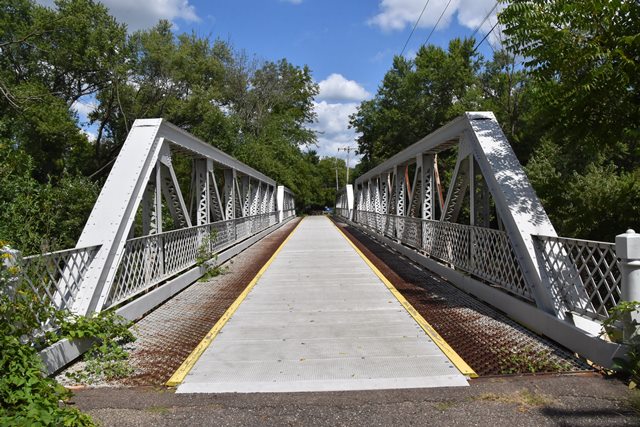We Recommend:
Bach Steel - Experts at historic truss bridge restoration.
Crystal Springs Bridge

Primary Photographer(s): Nathan Holth
Bridge Documented: August 24, 2019
Riverside Avenue (High Mill Avenue) (TR-352) Over Tuscarawas River
Crystal Springs: Stark County, Ohio: United States
Not Available or Not Applicable
104.0 Feet (31.7 Meters)
212.0 Feet (64.6 Meters)
16.4 Feet (5 Meters)
2 Main Span(s)
76XXXX3

View Information About HSR Ratings
Bridge Documentation
This uncommon multi-span pony truss bridge was preserved in place for pedestrian use. It has attractive lattice railing.
Information and Findings From Ohio's Historic Bridge InventorySetting/Context The bridge carries a trail over a stream in Crystal Springs Park. It is for pedestrian use only. Physical Description The approximately 220'-long, riveted Pratt pony truss bridge is supported on ashlar substructure units that predate this superstructure (old bridge lost in 1913 flood). Panels are about 20' long. The upper chords and inclined end posts are built up box sections and the diagonals and verticals are built up with back-to-back angles with lacing. There are original outriggers. Of particular note are the handsome lattice railings set inside the truss lines and the end fill panels with cast iron posts. The steel grid deck is not original. The plaque has been damaged, so it is not possible to read which firm fabricated the bridge if indeed that information was ever part of the plaque mounted to an inclined end post. Integrity The bridge maintains the aspects of integrity. Summary of Significance The riveted Pratt pony truss bridge was placed in
1914 to replace one lost in the great 1913 flood. It is a complete
example of its type, but it is not an early example nor does it have
innovative or distinctive details. There are at least 25 older riveted
truss bridges in the state Extant riveted truss bridges in Ohio date to
the turn of the 20th century, and it is the early examples that
chronicle the historical and technological significant of the design.
The plaque on this bridge has been damaged, so the fabricator is not
readily apparent. The completeness of the bridge makes it a fine example
of its type, design, and context. Bridge Considered Historic By Survey: No |
![]()
Photo Galleries and Videos: Crystal Springs Bridge
Bridge Photo-Documentation
Original / Full Size PhotosA collection of overview and detail photos. This gallery offers photos in the highest available resolution and file size in a touch-friendly popup viewer.
Alternatively, Browse Without Using Viewer
![]()
Bridge Photo-Documentation
Mobile Optimized PhotosA collection of overview and detail photos. This gallery features data-friendly, fast-loading photos in a touch-friendly popup viewer.
Alternatively, Browse Without Using Viewer
![]()
Maps and Links: Crystal Springs Bridge
Coordinates (Latitude, Longitude):
Search For Additional Bridge Listings:
Bridgehunter.com: View listed bridges within 0.5 miles (0.8 kilometers) of this bridge.
Bridgehunter.com: View listed bridges within 10 miles (16 kilometers) of this bridge.
Additional Maps:
Google Streetview (If Available)
GeoHack (Additional Links and Coordinates)
Apple Maps (Via DuckDuckGo Search)
Apple Maps (Apple devices only)
Android: Open Location In Your Map or GPS App
Flickr Gallery (Find Nearby Photos)
Wikimedia Commons (Find Nearby Photos)
Directions Via Sygic For Android
Directions Via Sygic For iOS and Android Dolphin Browser
USGS National Map (United States Only)
Historical USGS Topo Maps (United States Only)
Historic Aerials (United States Only)
CalTopo Maps (United States Only)

